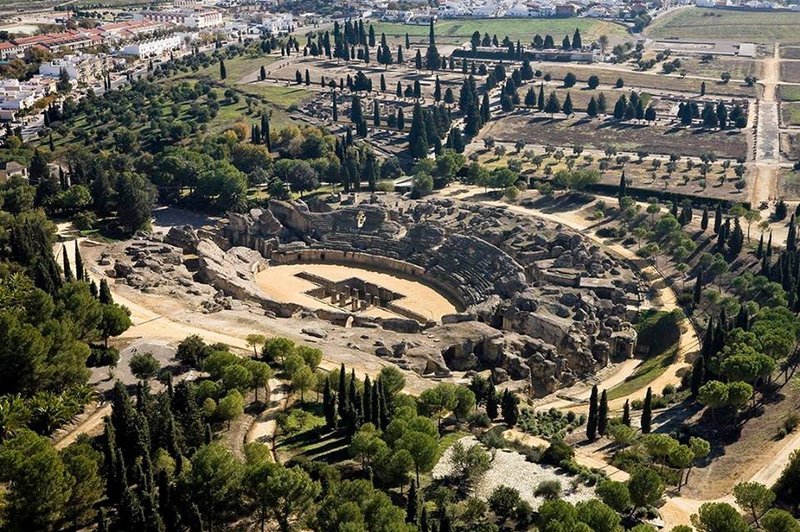
Hail Caesar, we who are about to visit Itálica salute you! Make your way to Santiponce and enjoy the historical wonder of Itálica, a small piece of Rome just a few minutes from Seville. There you can see the ruins of an ancient Roman city, the Monastery of San Isidoro del Campo as well as the Municipal Museum of Fernando Marmolejo. Don’t miss out!
Itálica Ruins
The ancient Roman city of Itálica is located in the lower Guadalquivir area, about halfway between Seville (previously known as the Roman city of Hispalis) and Alcalá del Río (previously known as Ilipa Magna), which is currently where the municipality of Santiponce is located. During the period of the High Roman Empire, Itálica was a strategic city, both in a political and military sense as well as from an economic standpoint, extending as a testament to this along its total surface of 54 hectares.
The origins of the architectural complex of Itálica date back to the year 206 C.E., during the historical context of the Second Punic War, when General Publio Cornelio Escipión defeated the Carthaginians in the battle of Ilipa and established a legionary detachment in the Cerro de San Antonio, which was populated by the Turdetani people from about IV C.E.
Despite the fact that, at the start, both communities lived together in this close enclave along the Guadalquivir River, the Roman society began to progressively impose their political model and their social customs onto the rest of society. As a result, Itálica was the birthplace of such emperors as Trajano or Adriano, as well as a point of origin for a majority of the senators of the time.
Currently, the architectural complex of Itálica allows visitors to take a walk through the incredible Roman amphitheater, which once had a capacity to hold 25,000 spectators, being one of the biggest amphitheaters of the empire. It had three descending levels and a large pit where representations of the different spectacles of fighting gladiators and beasts were carried out.
In addition to visiting the amphitheater, it is also possible to follow the pathway of the outline of the ancient streets of the Roman city and see the most important archaeological remains of Itálica such as the Temple of Trajano and the well-known “hot springs”. During your visit to the ancient Roman city, it is also possible to see homes, public buildings, artistic objects and the utensils of the day to day used by its past inhabitants.
Monastery of San Isidoro del Campo
Founded in the year 1301 by Alonso Pérez de Guzmán and María Alonso Coronel, its location is near the ruins of Itálica because, according to tradition, it was in that location where San Isidoro of Seville was laid to rest. From that point on, the Monastery of San Isidoro del Campo was under the spiritual mandate and management of different religious orders, such as, the Cistercians and the St. Jerome Hermits, which have left along the way, their own personal and characteristic impressions both in the construction and in the decoration of the premises.
It was not until the year 1432 when the St. Jerome hermits decided to carry out a deep structural reform in the monastery which was directly reflected in the concept of monastic life and subtly in some decorative aspects. In this characteristic monastery fortress, with a double church, the gothic style with the Mudejar style are juxtaposed, through which the Almohad tradition is clearly seen. With the Cistercian austerity, the monastery of St. Jerome is decorated with mural paintings that shape one of the more notable complexes, artistically speaking, in all of Spain.
With the passing of the years, the Monastery expanded and was enriched, finally having a tower, belfry, five cloisters and alongside the monacal units, a lodge and agricultural installations with personal cattle that was intended for them to stock up and be self-sufficient.
Currently, the Monastery of San Isidoro del Campo can be visited free of charge for visits that are approximately 45 minutes with the exception of Monday, which is when the Monastery is closed to public visits.
Municipal Museum of Fernando Marmolejo
Located next to the Roman theater, is the Municipal Museum of Santiponce where Fernando Marmolejo presents visitors with a wide surface of expositions in the lower floor, close to the access entrance of the museum, as well as, a higher floor with three different rooms, where temporary expositions are shown.
The permanent collection is made up of artistic work and archeological artifacts which were donated by the well-known goldsmith Fernando Marmolejo Camargo. Among the most highlighted art exhibitions, it is possible to visit a few reproductions of ancient archeological treasures commissioned by the Ministry of Culture, for example, the Crown of Recesvinto, the Tartessian candlestick from Lebrija or the Almohad Keys to the city of Seville.
